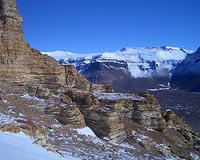 |
Pasadena CA (SPX) Nov 18, 2009 Impact craters on Mars are kind of neat. Many of them look very different than impact craters seen on Earth's moon or Mercury. Fresh lunar and Mercurian craters have ejecta blankets that look a bit rough near the crater rims; around larger craters, long rays or chains of secondary craters radiate away from the crater rims. Some Martian craters are similar to these craters, but Mars also has a high proportion of craters with forms not found on the moon or Mercury: rampart craters. Rampart craters, also called fluidized-ejecta craters, have ejecta blankets that appear lobate, or rounded, in plan view, and end in low ridges or ramparts. An example of a such a rampart is the ridge in this image from the High Resolution Imaging Science Experiment (HiRISE) camera on NASA's Mars Reconnaissance Orbiter. Here you see the rampart at the edge of an ejecta blanket that comes from an approximately 16-kilometer-diameter (10-mile-diameter) crater, about 16 kilometers (10 miles) to the east. For years there has been a debate about whether these lobes and ramparts were formed by ejecta interacting with the thin Martian atmosphere, or whether they formed because volatiles (such as water or ice) in the subsurface were incorporated into the ejecta material excavated by the impact. The common consensus is now in favor of the volatile hypothesis. Because of this, rampart craters can be used to indicate the past presence of water or ice in the Martian crust. This image covers a swath of ground about 6 kilometers (4 miles) wide, centered at 17.2 degrees north latitude, 311.6 degrees east longitude. Share This Article With Planet Earth
Related Links NASA Mars Reconnaissance Orbiter Mars News and Information at MarsDaily.com Lunar Dreams and more
 Taking A Bite Of Antarctic Ice
Taking A Bite Of Antarctic IceMoffet Field CA (SPX) Nov 17, 2009 Scientists with NASA's IceBite project are heading this week for University Valley, a hanging valley perched more than 1600 feet (more than 1 mile) above sea level in Antarctica's McMurdo Dry Valleys. Their objective: to test a set of ice-penetrating drills and select one for use on a future mission to the martian polar north, the same region of the planet that NASA's Phoenix lander ... read more |
|
| The content herein, unless otherwise known to be public domain, are Copyright 1995-2009 - SpaceDaily. AFP and UPI Wire Stories are copyright Agence France-Presse and United Press International. ESA Portal Reports are copyright European Space Agency. All NASA sourced material is public domain. Additional copyrights may apply in whole or part to other bona fide parties. Advertising does not imply endorsement,agreement or approval of any opinions, statements or information provided by SpaceDaily on any Web page published or hosted by SpaceDaily. Privacy Statement |